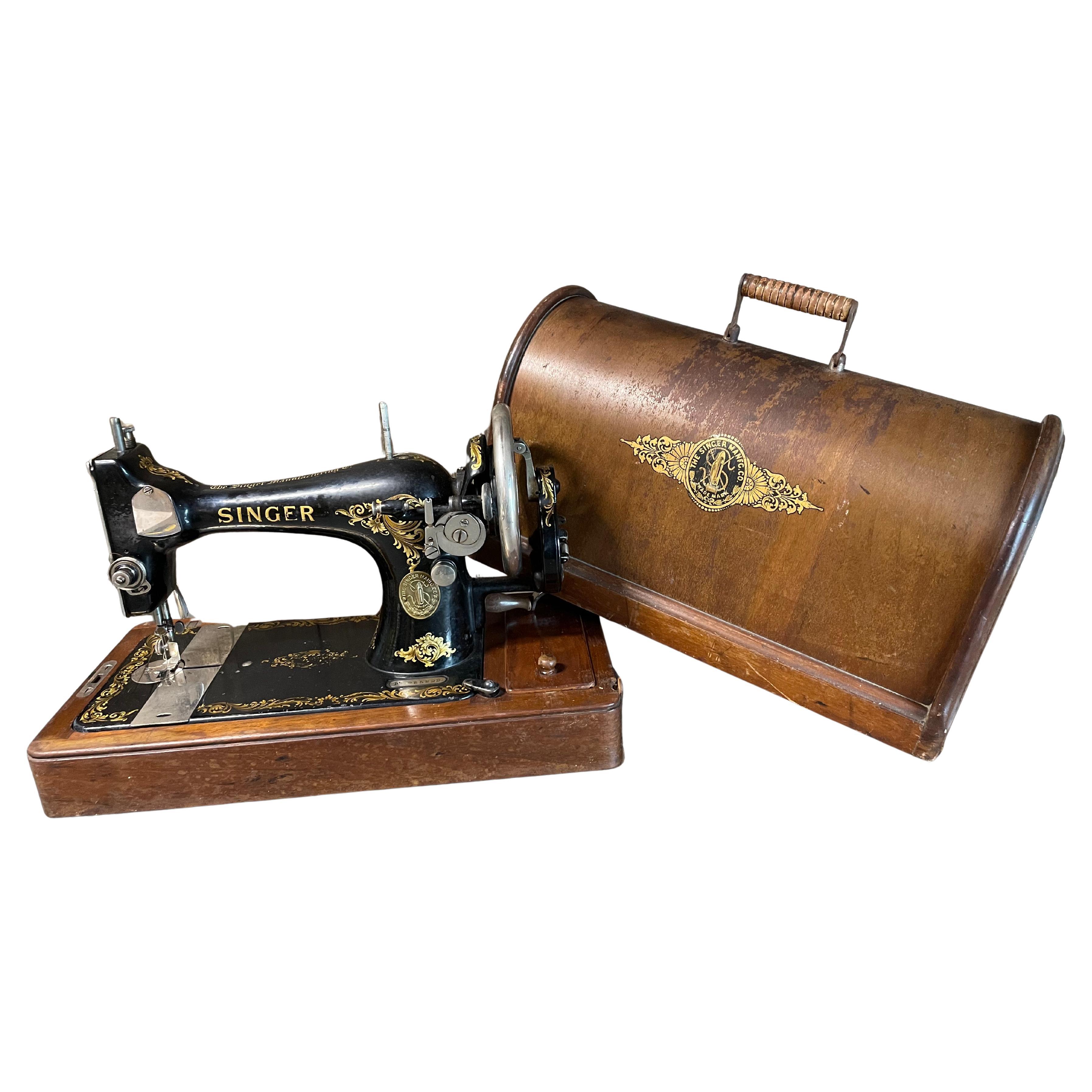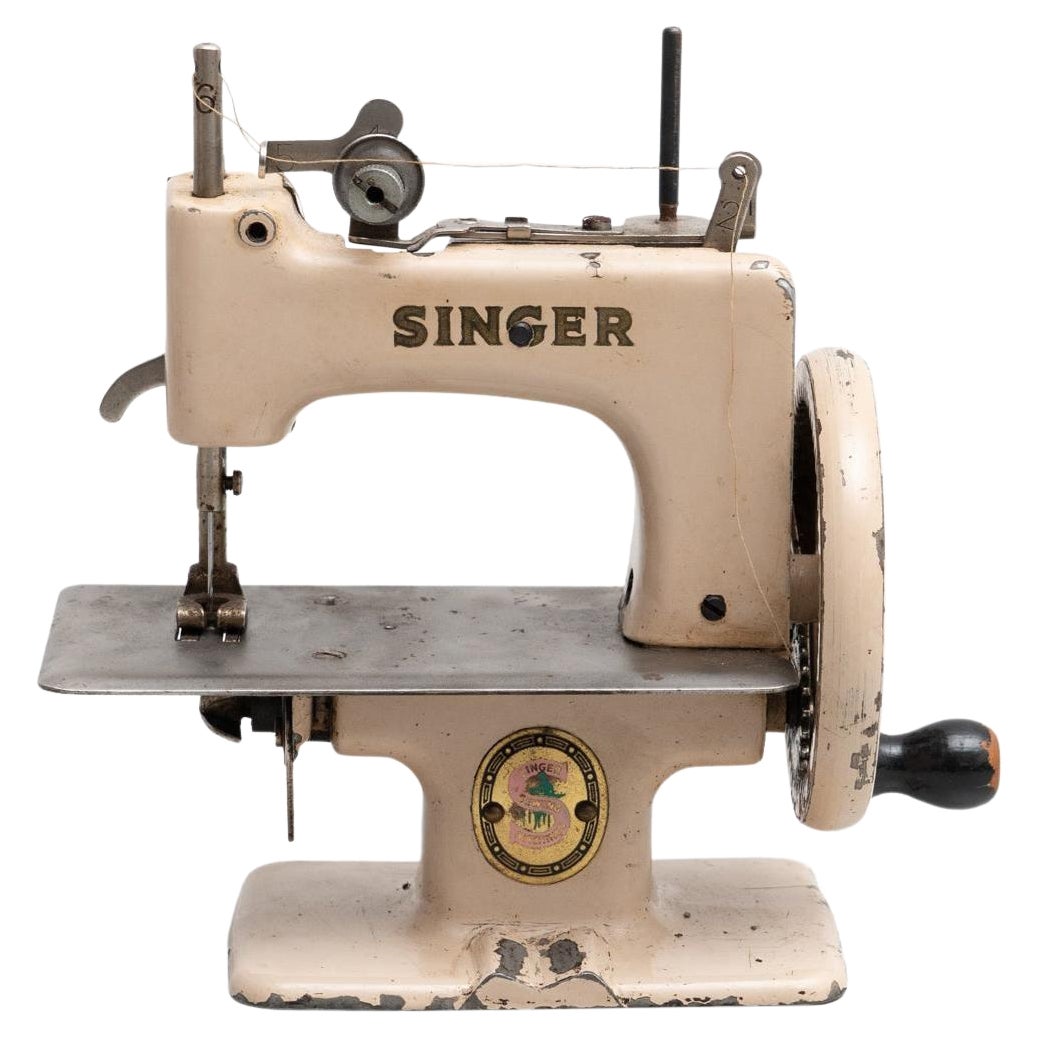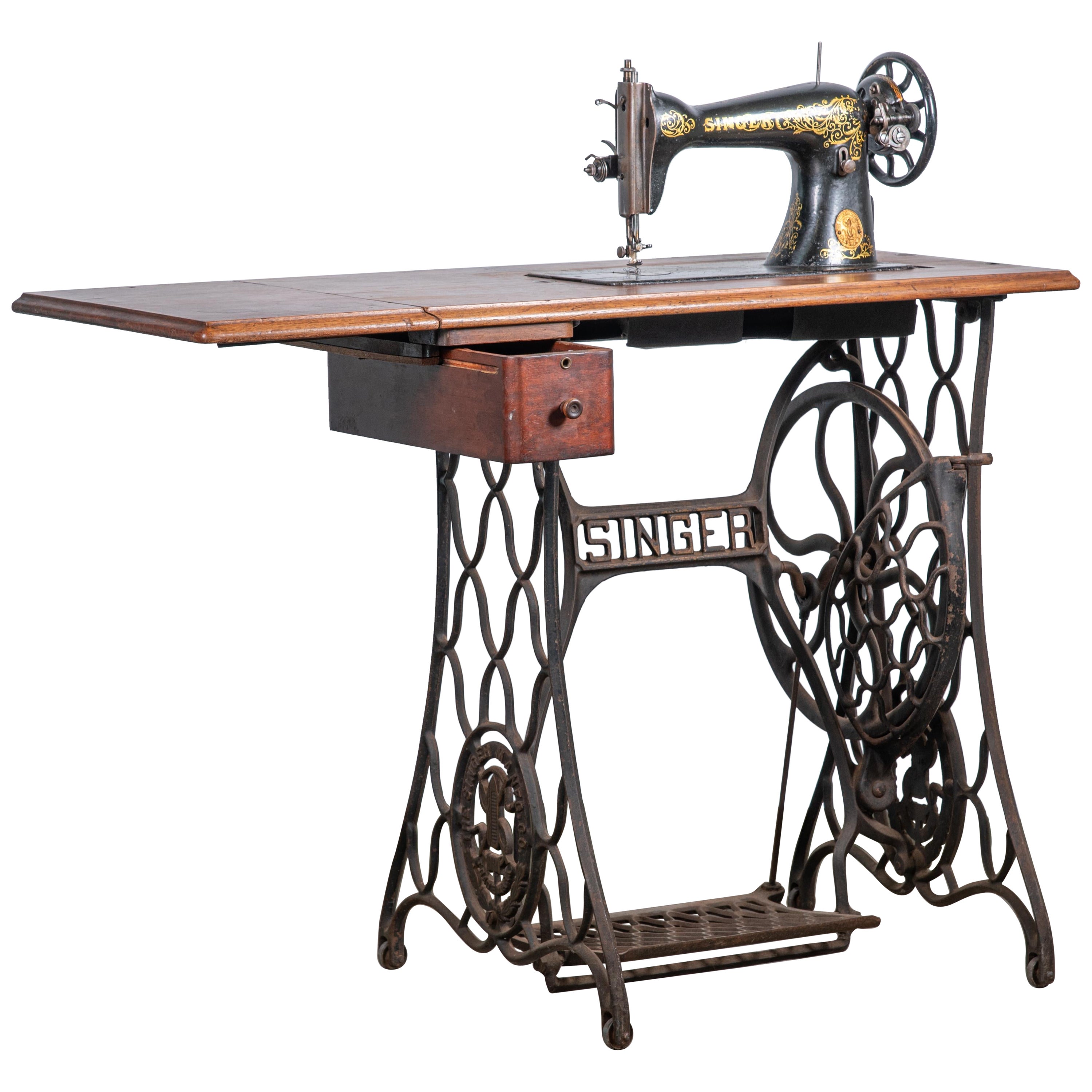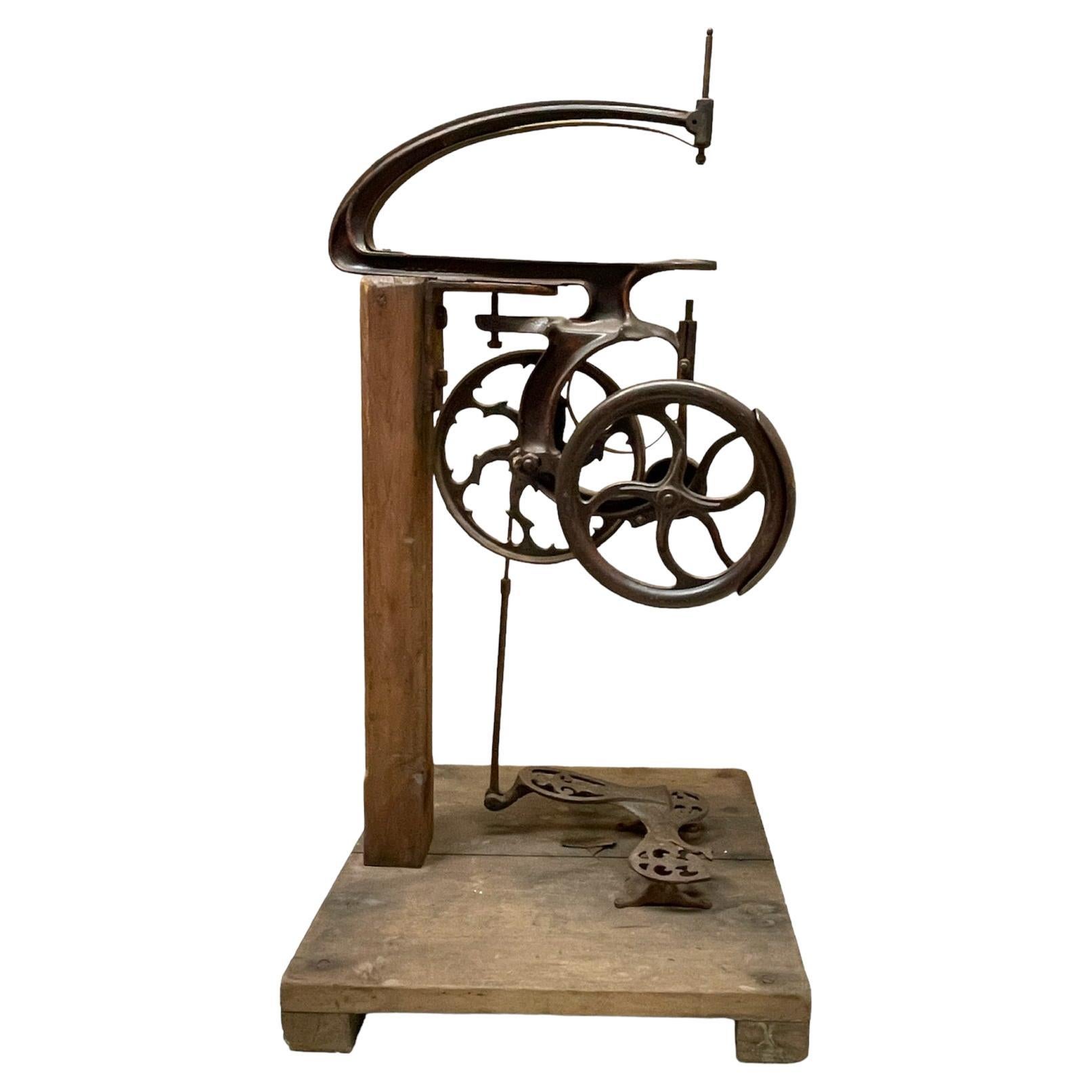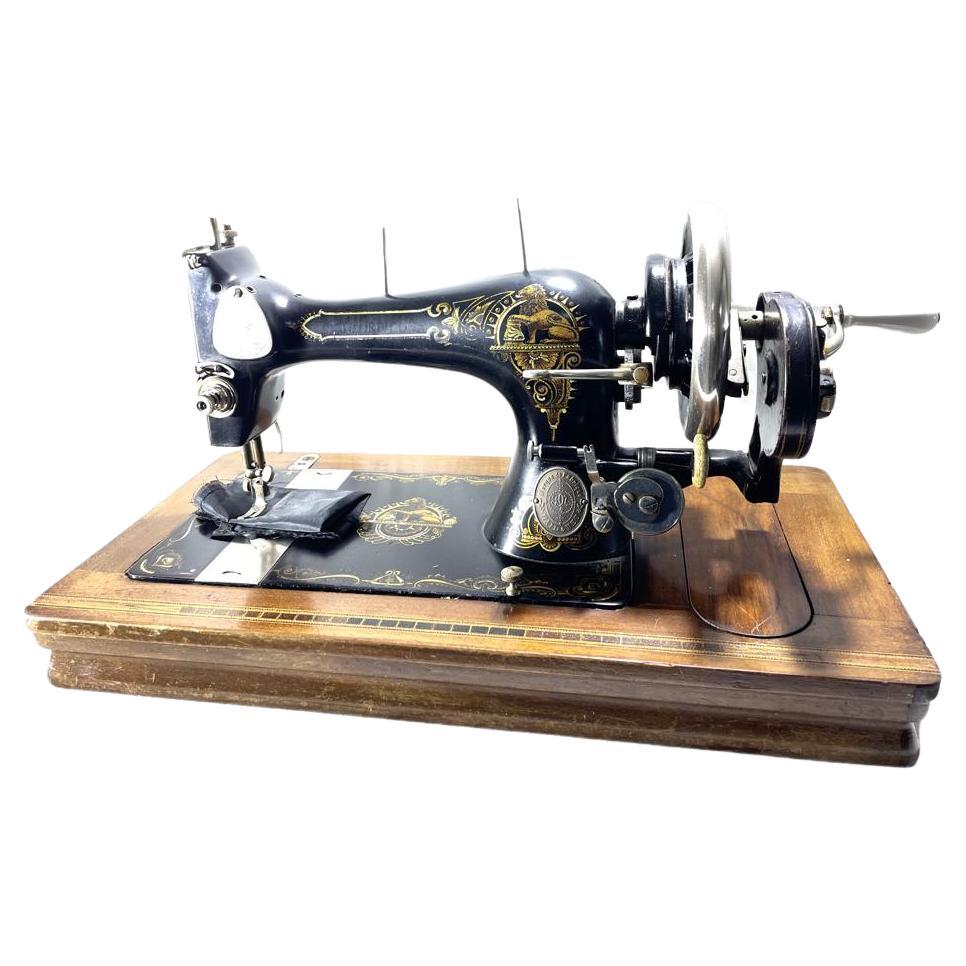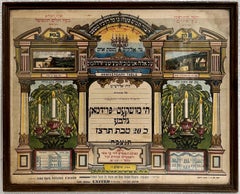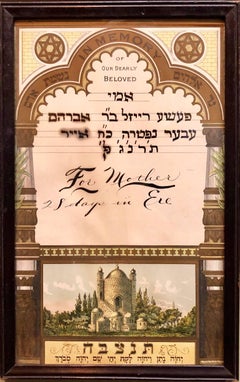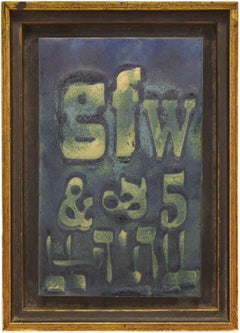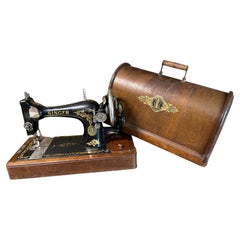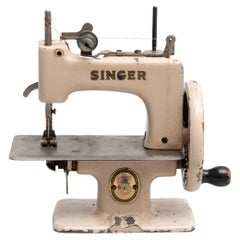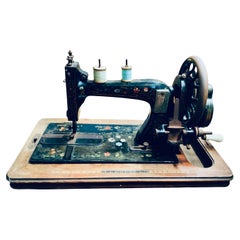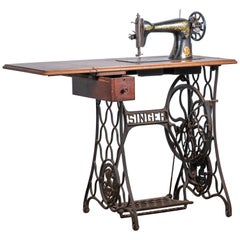Items Similar to Rare Antique Enamel Singer Sewing Machine Sign - Hebrew
Want more images or videos?
Request additional images or videos from the seller
1 of 6
UnknownRare Antique Enamel Singer Sewing Machine Sign - Hebrewcirca 1920
circa 1920
$2,500
£1,900.69
€2,193.47
CA$3,499.33
A$3,918.31
CHF 2,044.38
MX$47,741.79
NOK 25,941.74
SEK 24,663.68
DKK 16,372.79
Shipping
Retrieving quote...The 1stDibs Promise:
Authenticity Guarantee,
Money-Back Guarantee,
24-Hour Cancellation
About the Item
Rare antique enamel Vintage Singer Sewing Machine advertisement Sign in Hebrew or Yiddish. Please see photos for condition. Rare early Jewish advertising memorbilia
This early twentieth century metal sign is an advertisement by the Singer Manufacturing Company (now called The Singer Company) for Singer Sewing Machines. Although Isaac Merritt Singer, the company’s founder, did not invent the sewing machine, his innovative design dramatically improved the capabilities of existing models. Possessing both technical expertise as well as a flair for business, Singer was the first to look beyond the commercial market and see tremendous opportunity – as yet untapped – selling sewing machines directly to households.
Singer’s inspired vision made it possible for millions of people, including immigrants on the Lower East Side, to buy their own sewing machines. By the 1850s, intrigued by the potential of mass production – a new technique then used to manufacture firearms – he adopted the same methods to mass-produce sewing machines. Production costs dropped significantly, enabling Singer to cut his machine’s sticker price from $100 to $10. Striving to make sewing machines even more affordable to average families, Singer’s company was also the first to offer an installment payment plan, allowing customers with limited income to buy now and pay back over time.
For many immigrants on the Lower East Side, affordable sewing machines presented an opportunity to earn a better living. By the turn of the century, more than half of the workers on the Lower East Side worked in the garment industry. By 1910, 70% of the nation’s women’s clothing and 40% of the men’s was produced in New York City. Many immigrants set up garment shops inside their tenement apartments and a Singer Sewing Machine was an invaluable investment. Although hand stitching was still demanded for certain kinds of detail work, it was impossible to compete with the speed of a sewing machine for less painstaking work. An experienced seamstress could easily sew 40 stitches per minute by hand, but at 900 stitches per minute, a skilled sewing machine operator was capable of working nearly 23 times faster.
From the Museum at Eldridge street
This metal sign advertised the sewing machine to Jewish clientele in Yiddish. The red square-like shape is the Yiddish letter samech and makes the “s” sound. Notice the same letter on the bottom of the sign where the name “Singer” is written in Yiddish characters. The top of the sign reads mechonos tefira, Yiddish for sewing machines.
- Creation Year:circa 1920
- Dimensions:Height: 38 in (96.52 cm)Width: 26 in (66.04 cm)
- Medium:
- Period:
- Condition:please see photos.
- Gallery Location:Surfside, FL
- Reference Number:1stDibs: LU38210796122
About the Seller
4.9
Platinum Seller
Premium sellers with a 4.7+ rating and 24-hour response times
Established in 1995
1stDibs seller since 2014
1,782 sales on 1stDibs
Typical response time: <1 hour
- ShippingRetrieving quote...Shipping from: Surfside, FL
- Return Policy
Authenticity Guarantee
In the unlikely event there’s an issue with an item’s authenticity, contact us within 1 year for a full refund. DetailsMoney-Back Guarantee
If your item is not as described, is damaged in transit, or does not arrive, contact us within 7 days for a full refund. Details24-Hour Cancellation
You have a 24-hour grace period in which to reconsider your purchase, with no questions asked.Vetted Professional Sellers
Our world-class sellers must adhere to strict standards for service and quality, maintaining the integrity of our listings.Price-Match Guarantee
If you find that a seller listed the same item for a lower price elsewhere, we’ll match it.Trusted Global Delivery
Our best-in-class carrier network provides specialized shipping options worldwide, including custom delivery.More From This Seller
View AllRare Palestine Antique Hebrew Judaica Yahrzeit Synagogue Sign Memorial Plaque
Located in Surfside, FL
Circa 1890-1920. This Neoclassical, Judaic, Egyptian revival, Orientalist Mizrach sign, was produced in British Mandate Palestine by the chromolithograph process at the beginning of the 20th century. It pictures vignettes of holy places. with a hand written memorial. It was for the Tzedakah charity fund for the century-old institutions in Jerusalem: The great "Torah Center Etz Chaim"; a Free Kitchen for poor children and orphans; the famous Bikur Cholim Hospital with its dispensaries and clinics and the only Home for Incurable Invalids in Eretz Israel. They also worked with Arthur Szyk and Alfred Salzmann.. The A.L. Monsohn Lithographic Press (Monzon Press, Monson Press, דפוס אבן א"ל מאנזאהן, דפוס מונזון) was established in Jerusalem in 1892 by Abraham-Leib (or Avrom-Leyb) Monsohn II (Jerusalem, c.1871-1930) and his brother Moshe-Mordechai (Meyshe-Mordkhe). Sponsored by members of the Hamburger family, the brothers had been sent to Frankfurt, Germany in 1890 to study lithography. Upon returning to Jerusalem in 1892 with a hand press, they established the A.L. Monsohn Lithographic Press in the Old City of Jerusalem. According to the Information Center for Israeli Art A.L. Monsohn "created complex decorations for documents and oriental calendars that combined the tradition of Jewish art with modern printing techniques such as photographic lithography, raised printing and gilding."
The founders of the Monsohn press produced Jewish-themed color postcards, greeting cards, Jewish National Fund stamps, and maps documenting the evolution of the Jewish settlement in Eretz Israel in the nineteenth-twentieth centuries; religious material such as decorative plaques for synagogues, portraits of Old Yishuv rabbis such as Shmuel Salant, Mizrah posters indicating the direction of prayer for synagogues, memorial posters, and posters for Sukkot booths; color frontispieces for books such as Pentateuch volumes and the early song collections of Abraham Zvi Idelsohn (e.g., Shire Zion, Jerusalem 1908); artistic wedding invitations; and labels, packaging and advertisements for the pioneering entrepreneurs of Eretz Israel. The texts appearing in the Monsohn products were in several languages: Hebrew, Arabic, Yiddish, English, German (e.g., a c1920 trilingual Hebrew-English-Arabic "Malaria Danger" broadside warning the public of mosquitoes spreading malaria). Many of the brilliantly colored postcards and maps can be seen online as can the artistic invitations to his children's weddings which Monsohn published in the Jerusalem Hebrew press.
For years, the Monsohn (later, Monson/Monzon) Press was considered the best and most innovative in the country—pioneering in such techniques as gold-embossing and offset printing, among others. Early items for tourists included collections of Flowers of the Holy Land (c. 1910–1918)—pressed local flowers accompanied by scenes from the Eretz Israel countryside and relevant verses from the Bible, edited by Jsac Chagise (or Itzhak Haggis), an immigrant from Vitebsk, and bound in carved olive wood boards. Shortly after World War I Monsohn (now spelled מונזון) used zincography to produce the prints included in the Hebrew Gannenu educational booklets for young children illustrated by Ze'ev Raban of the Bezalel Academy of Art and Design and printed in Jerusalem by Hayim Refael Hakohen (vol. 1, 1919; vols. 2–3, 1920). In 1934 Monsohn moved into the new, western part of Jerusalem, in a shop with four presses and 30 workers, including Abraham-Leib's sons, David, Yosef, Moshe and Shimon, and his daughter Raytse's husband, Abraham Barmacz. The concern did business with all sectors of the city's population, including Arabs, for whom they printed in Arabic. Among their clients were members of the Ginio, Havilio, and Elite families, and Shemen, Dubek, and other renowned national brands, manufacturing products such as wine, candies, oil, and cigarettes. They also printed movie and travel posters, and government posters, postcards and documents, hotel luggage labels...
Category
Early 20th Century Aesthetic Movement More Art
Materials
Lithograph
Rare Judaica 1893 Jewish Yizkor Memorial Plaque Hebrew English Chromolithograph
Located in Surfside, FL
A rare Judaic memorial piece for mother.
Category
Late 19th Century Aesthetic Movement More Prints
Materials
Lithograph
Typeface, Hebrew Font and Numbers Enamel Judaica Art Plaque
By George F Welch
Located in Surfside, FL
Dimensions w/Frame: 10" x 7 1/2" x 1 1/2"
A George F. Welch Abstract Copper Enamel Wall Art Plaque Inscribed signature on the lower right of the plaqu...
Category
20th Century Modern Mixed Media
Materials
Enamel
Rare European 19C Judaica Havdalah Hebrew Plate
Located in Surfside, FL
Here is a rare late 19th Century-early 20th Century painted and stenciled Jewish plate with a Yiddish greeting. A rare piece of Jewish Porcelain from the...
Category
Late 19th Century Folk Art More Art
Materials
Porcelain
Vintage Jerusalem Sculpture Wall Plaque 1930's Palestine Israeli Bezalel School
Located in Surfside, FL
Repousse sculptural plaque from the original Bezalel Art School in Jerusalem.
This is marked "Made in Palestine" as it is from the British Mandate period. It is in an Orientalist des...
Category
20th Century Modern More Art
Materials
Metal
Judaica Imagery on Wood Contemporary Pop Art Manner
Located in Surfside, FL
A silkscreen mixed-media work that exhibits the word "Forefathers" in Hebrew across the bottom of the piece.
Category
Late 20th Century Contemporary Mixed Media
Materials
Wood, Mixed Media, Acrylic, Black and White
You May Also Like
Singer portable sewing machine
Located in Nivelles, BE
Singer portable sewing machine, late 19th/early 20th century, fine writing on box and machine.
Quite rare for a portable.
For decoration but could be restored for use.
Category
Antique Late 19th Century Central American Arts and Crafts Antiquities
Materials
Beech
Antique Century Traditional Toy Singer Sewing Machine Reproduction, circa 1950
Located in Barcelona, ES
Vintage metal toy Singer sewing machine reproduction. In original condition, wear consistent with age and use, preserving a beautiful patina. Materials: Metal.
Category
Vintage 1950s Spanish Mid-Century Modern Toys
Materials
Metal
$889 Sale Price
50% Off
19th Century Clemens Muller Sewing Machine
Located in Guaynabo, PR
This is a 19th Century Clemens Muller Sewing Machine. It is made of cast iron painted black and adorned with bouquets of flowers decals and mothe...
Category
Antique Late 19th Century German Machine Age Models and Miniatures
Materials
Iron
19th Century Singer Sewing Machine
Located in Austin, TX
Transport yourself back in time with our exquisite 19th-century Singer Sewing Machine, discovered in France. Crafted with a sturdy cast iron base and an elegant oak frame, this vinta...
Category
Antique Late 19th Century French Historical Memorabilia
Materials
Iron
Antique 19th Century Trumper Co.Sewing Machine
Located in Guaynabo, PR
This is a 19th century Trumper Co., Wilmington Pedal Sewing Machine. It depicts a rectangular wood base with a tall wide piece of wood standing in 90 degree position in the mid late...
Category
Antique 19th Century American Industrial Antiquities
Materials
Metal
$1,820 Sale Price
20% Off
Antique Century Traditional Sewing machine Vibrating, circa 1950
Located in Roma, IT
Antique sewing machine Vesta Handcrank vibrating shuttle
Serial Number: 2655227
Made in Germany
Ideal for sewing most materials such as denim, canvas, silk, calico and the like,
Could be used as was intended for sewing or recycled as a small office ornament...
Category
Vintage 1950s European Cabinets
Materials
Metal
More Ways To Browse
Time Machine
Vintage Business Sign
Vintage Enamel Signs
Hebrew Art
Lower East Side
Signed In Hebrew
Jewish Antiques
Jewish Metal Art
Sewing Machine
Metal Sewing
Vintage Metal Advertising Signs
Singer Sewing
Singer Sewing Machine
Enamel Sign Vintage Advertising Signs
Antique Metal Advertising Signs
Vintage 40s Mens Clothing
70s Vintage Clothing Mens
Mens Vintage 70s Clothing
